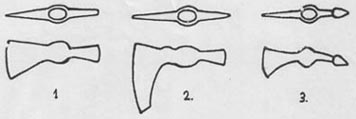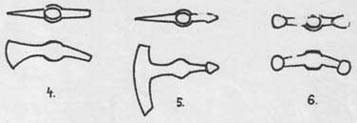|
Last Page Update:
October 3, 2002
Contact
Copyright Information
Main Page
Structure of the Red Kaganate
Gatherings, Events, . . .
Historic Steppes Tribes
Legends of the Nomads
Flags and other Identifiers
Clothing and Apearance
Food and related Matters
Armour
Weapons and Combat
Public Forum
Resource Links
Email:
kaganate@yahoo.com
Editor:
Norman J. Finkelshteyn
|
An Overview of Western Steppe Axes
(with a focus on Hungarian culture)
By Russ Mitchell
While the axe did not have the honored place in grave
burials and social caste that we have found to be the
case with the sabre, it was nevertheless a common
weapon of war.
The axe has several advantages over
other hand weapons. First of all, its value for
penetrating armor is second-to-none. Second, it is a
very durable weapon: not only is it unlikely to
break, it also retains most of its effectiveness when
the edge is dulled, due to the splitting nature of its
cuts. Third, it can be thrown, and a thrown axe is
very difficult to parry – and if ethnographic data
holds true, extremely accurate. In recent times,
a Transylvanian pig-herder was expected to be able to
knock a boar unconscious by hitting him behind the ear
with an axe thrown from twenty paces.
 |
| 1. Baltas Szekerce | 2. Baltas Bard |
3. Fokos Balta |
The images here give several types of axes. These are only a shortened illustration, for the number of
variations were immense. There is a Hungarian book of
arms (which I unfortunately do not have) that gives
illustrations of no fewer than 25 distinctly different
surviving axe heads from this period.
 |
| 4. Fokos Balta | 5. Fokos Bard |
6. Kettos Fokos |
Of these, the first is the “balta”. This refers to an
axe with a tomahawk-like splitting head, very similar
to those depicted in Carolingian miniatures. The haft
may have been long or short, but was usually long.
(NB: this is based on current research. Since wooden
axe hafts usually don’t survive burial, this is open
to challenge if other material arises.)
 |
| 7. Balta | 8. Bard |
9. Nyeltamaszos Balta
|
The other main variant is called a “bard”. It has a
thin bearded edge, with roughly an inch of clearance
between the bottom of the edge and the axe haft. This
gives it greater utility for trapping weapons. This
weapon is not a streitaxe, but has a thinner, narrower
head that is farther from the haft. The hafts for
this could be long or short, and in the later Middle Ages, in the
16th century, is often depicted with a short haft
worn in the belt as a parrying weapon.
 |
10. Nyeltamaszos Bard
11. Balta
|
There is an axe type found with a head similar to a
bard, but with a long socket to protect the shaft. This weapon is considered to be taken from the Rus
and/or the Bessenyő/ Pechenegs, and is almost
invariably short-hafted.
Then it gets complicated.
There is a kind of axe with
a long haft called the “fokos” (the "s" is pronounced as "sh" -- as in “sugar.”). The fokos is a cultural icon amongst the
Hungarians – even today, schoolboys get small wooden
toy fokos when they graduate from grade school, and
many canes are made in the form. It was a military
issue weapon not only until the renaissance, but even
up to WWI. The best translation for this word is
“backed.” A fokos may have a bard or balta blade
backed by another bard blade (in the middle ages, never two balta), a
hammer, a very short fan-like cutting blade, a spike,
an oval knob, or even a hook.
Even more complex, with the exception of the hook (which is mostly from the renaissance onward), any of these may complement any other. So you may have a balta-faced, knob-backed fokos
(technically fokosbalta), two knobs backing each
other, a spike and hammer head (though from
the renaissance onward it is called a hadicsakány, or
military pick), two hammer heads, two balta heads,
etc.
Most common were the axe heads, backed with
spikes, knobs, and hammer-heads.
|



